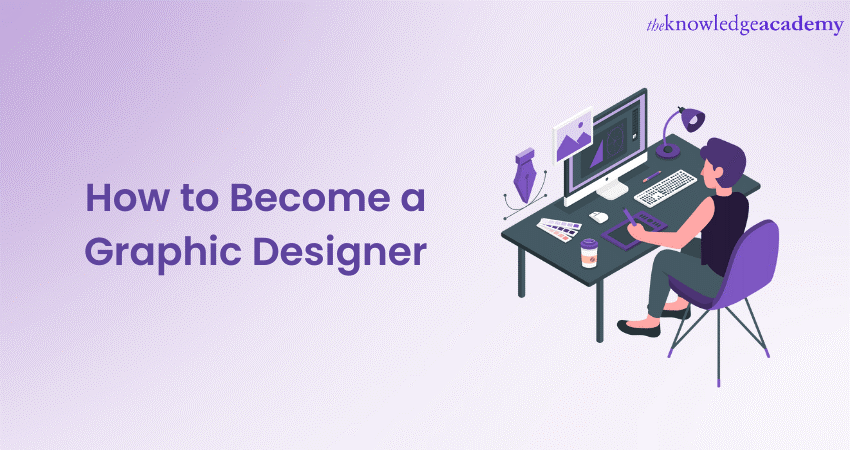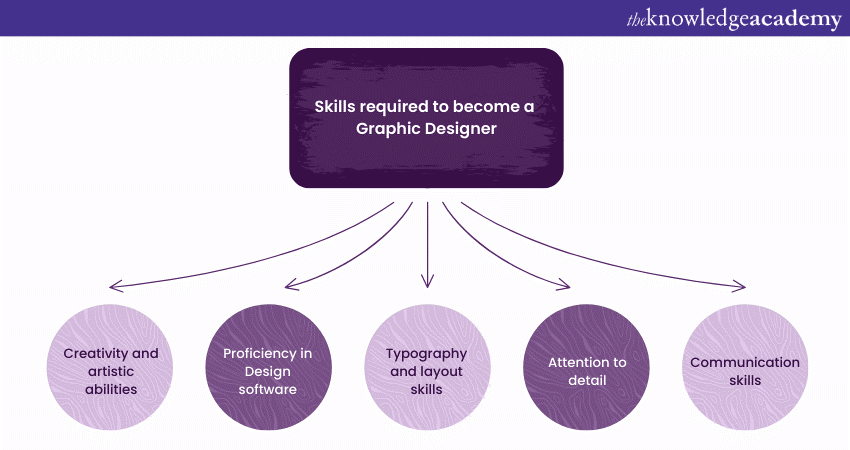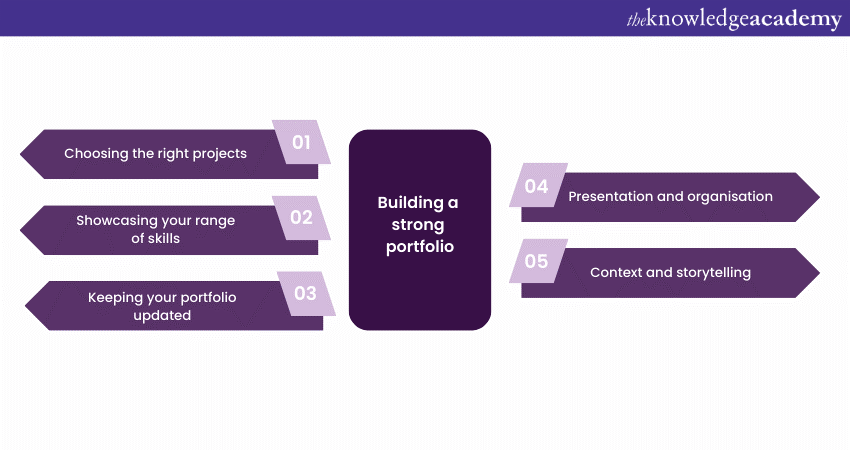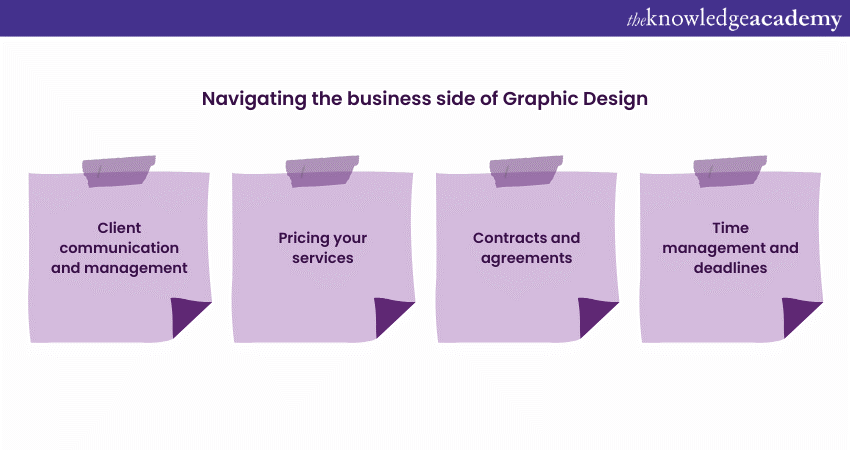We may not have the course you’re looking for. If you enquire or give us a call on 01344203999 and speak to our training experts, we may still be able to help with your training requirements.
Training Outcomes Within Your Budget!
We ensure quality, budget-alignment, and timely delivery by our expert instructors.

Graphic Design has evolved into a dynamic and influential profession. From crafting captivating logos that symbolise brands to conceptualising stunning layouts that tell stories, Graphic Designers are the visual architects who transform ideas into compelling visuals. This evolving field has lead many budding Graphic Designers to ask: How to Become a Graphic Designer?
If you've ever wondered How to Become a Graphic Designer and wish to embark on a journey of creativity, this blog will answer all your questions. In this blog we will dive into the diverse Graphic Design space, offering a roadmap for aspiring Designers to navigate this exciting field.
Whether you're an artistic soul seeking a creative outlet, or a tech-savvy individual intrigued by the fusion of aesthetics and technology, the path to becoming a Graphic Designer is filled with possibilities.
Table of contents
1) What is Graphic Design?
2) Skills required to become a Graphic Designer
3) Education qualifications required to become a Graphic Designer
4) Building a strong portfolio
5) Understanding Design principles
6) Navigating the business side of Graphic Design
7) Conclusion
What is Graphic Design?
Graphic Design combines creativity and communication to visually convey ideas, messages, and stories. It's the harmonious fusion of aesthetics and functionality, where visual elements are crafted thoughtfully to engage, inform, and inspire. Graphic Designers are the visual storytellers of our time, using their skills to transform concepts into compelling visuals that resonate with audiences across various mediums. Graphic Design consists of various disciplines, including but not limited to the following:
a) Visual identity Design: Creating logos, branding elements, and visual guidelines that define a company's image and personality.
b) Print Design: Crafting layouts for printed materials like brochures, posters, magazines, and packaging, ensuring they are visually appealing and easily comprehended.
c) Web and app Design: Designing User Interfaces (UI) and User Experiences (UX) for websites and applications, focusing on user-friendly navigation and aesthetic coherence.
d) Illustration: Producing hand-drawn or digitally created images that enhance a message or concept.
e) Typography: Selecting and arranging fonts to enhance readability and evoke specific emotions.
f) Motion Graphics: Designing animated visuals for videos, presentations, and multimedia content.
g) Environmental Design: Creating visuals for physical spaces such as exhibitions, retail environments, and public areas.
Skills required to become a Graphic Designer
When embarking on a journey to learn How to become a Graphic Designer, the first step is to gather knowledge on the skillset required by these professionals. Here are the essential skills you need to cultivate to excel in this dynamic and competitive field follow the path on How to be a Graphic Designer:

Creativity and artistic abilities
Candidates that are keen on understanding How to be a Graphic Designer, must note that theseskills involve possessing the following key competencies:
Visual thinking: The ability to conceptualise and translate abstract ideas into visually compelling Designs.
Imagination: A knack for thinking outside the box and generating innovative solutions.
Aesthetic sensibility: A keen eye for colour, composition, and visual harmony.
Apply analytical thinking skills to solve problems by signing up for our Travel Agent Masterclass now!
Proficiency in Design software
Candidates that are keen on understanding How to be a Graphic Designer, must note that the Proficiency in Graphic Design software means having a knowledge of the following tools:
Adobe creative suite: Mastery of industry-standard software like Photoshop, Illustrator, and InDesign for image editing, vector graphics, and layout Design.
UI/UX tools: Familiarity with tools like Sketch, Figma, or Adobe XD for Designing User Interfaces and experiences.
Typography and layout skills
Candidates interested to acquire clarity about How to be a Graphic Designer, must have the following capabilities:
Typography: Understanding the nuances of fonts, typefaces, and their impact on readability and aesthetics.
Layout Design: Organising elements on a page or screen in a visually pleasing and structured manner.
Attention to detail
Candidates interested to be more informed about How to be a Graphic Designers should understand that attention to detail means possessing the following:
Precision: Considering alignment, spacing, and proportions to ensure a polished final product.
Quality control: Thoroughly reviewing Designs for errors before finalising and delivering them.
Communication skills
Having great communication skills results in successful interactions for candidates that are actively working towards progress on the path of How to be a Graphic Designer. Have a look at the following scenarios:
Client collaboration: Effectively understanding and translating client needs into visual concepts.
Visual communication: Conveying ideas and messages through visuals that resonate with the target audience.
Problem-solving abilities
Candidates who are passionate about understanding how to get into Graphic Design, must nknow that having problem-solving abilities results in being capable of the following:
Analytical thinking: Identifying Design challenges and devising creative solutions that meet project objectives.
Adaptability: Open to revising and refining Designs based on feedback and evolving requirements.
Time management
The ability to manage time effectively helps in the following:
Prioritisation: Juggling multiple projects and deadlines by managing time efficiently.
Project planning: Breaking down larger projects into manageable tasks and setting realistic timelines.
Technology proficiency
Being technologically proficient aids in the following:
Staying updated: Keeping up with the latest Design software updates, tools, and industry trends.
Digital illustration: Developing skills in creating digital artwork using tools like Wacom tablets and digital brushes.
Collaboration skills
Possessing collaboration skills helps you thrive in the following scenarios:
Teamwork: Working effectively with other Designers, developers, copywriters, and clients to achieve a cohesive result.
Feedback incorporation: Being receptive to constructive criticism and using it to enhance your Designs.
Education qualifications required to become a Graphic Designer
Your education choice often shapes the path to becoming a skilled Graphic Designer. While formal education is optional, it can provide a solid foundation and open doors to opportunities for growth and specialisation. Here are the various educational paths you can consider:
Formal education (Degree programs)
Below listed are formal education requirements for a Graphic Designer:
a) Bachelor's degree in Graphic Design: A Bachelor's degree provides a comprehensive education covering Design theory, software proficiency, and practical projects. It often includes typography, colour theory, illustration, and Design history courses.
b) Associate degree: A two-year Associate's degree in Graphic Design can provide a condensed version of the Bachelor's program, focusing on core Design skills and software proficiency.
c) Related degrees: Some Graphic Designers come from fields like fine arts, communication, or marketing, bringing their unique perspectives to the Design process.
Online courses and tutorials
Let's look at the benefits online courses provide in the Graphic Design profession:
a) Online platforms: Many online websites offer various Graphic Design courses, from beginner to advanced levels.
b) Specialised courses: You can take courses focusing on specific Design software, techniques, or niche areas within Graphic Design.
c) Self-paced learning: Online courses enable you to learn quickly and apply your skills immediately.
Self-study and skill building
Self-study can also contribute significantly for relevant skill development, let us see how:
a) Books and resources: There are numerous books, blogs, and online resources that teach Design principles, software usage, and Design theory.
b) Practice projects: Engaging in personal Design projects allows you to experiment, refine your skills, and build a diverse portfolio.
c) Mentorship: Connecting with experienced Designers for guidance and feedback can be invaluable in your self-study journey.
Importance of building a portfolio
Building a portfolio is also a crucial part in the journey of becoming a Graphic Designer, let's explore briefly in this section:
a) Showcasing skills: A portfolio visually represents your abilities and style. Showcasing skills and expertise to potential clients or employers is crucial.
b) Project variety: Including a mix of projects, such as logos, posters, web designs, and branding, showcases your versatility as a Designer.
c) Continuous update: Regularly adding new projects to your portfolio demonstrates growth and keeps your work relevant.
Certifications and specialisations
Certifications provide an inexpensive alternative to formal education, listed below are some for your reference:
a) Adobe certifications: Adobe offers certifications for software programs like Photoshop, Illustrator, and InDesign, validating your proficiency.
b) Specialisation tracks: Some programs offer specialised certifications in UI/UX Design, motion graphics, or digital marketing.
Importance of practical experience
Let us go over the methods using which you can gain practical experience:
a) Internships: Interning with Design agencies or companies provides hands-on experience, exposes you to real-world projects, and helps you build a professional network.
b) Freelance work: Taking on freelance projects allows you to apply your skills, manage clients, and develop a business mindset.
c) Personal projects: Creating passion projects or Design challenges lets you experiment without client constraints, fostering creativity.
Learn how to get images into and out of GIMP, sign up for our GIMP Training now!
Building a strong portfolio
Another step when learning How to Become a Graphic Designer is to build a well-crafted portfolio serves as it serves as a visual gateway to your skills, style, and versatility. It's a testament to your capabilities and an essential tool for attracting clients, employers, and collaborators. Here's how to construct a compelling portfolio that leaves a lasting impression:

1) Choosing the right projects:
a) Diversity: Include a variety of projects that showcase your range, from logo designs and branding to print materials and digital interfaces.
b) Passion projects: Incorporate personal projects that reflect your interests and creativity, demonstrating your motivation beyond client work.
c) Relevance: Tailor your portfolio to the type of work you want to attract. If you're interested in web design, showcase web-related projects prominently.
2) Showcasing your range of skills:
a) Process: Share not only the final Designs but also the Design process. Include sketches, wireframes, and mock-ups to illustrate your creative journey.
b) Software proficiency: Highlight your proficiency in Design software by presenting polished and professional pieces.
c) Typography and layout: Showcase your expertise in typography and layout design, as they are crucial elements in many Design projects.
3) Keeping your portfolio updated:
a) Regular updates: Add new projects to your portfolio to demonstrate growth and keep your work current.
b) Quality over quantity: It's better to have fewer high-quality pieces than a large quantity of mediocre ones.
4) Presentation and organisation:
a) Clean layout: Design your portfolio website with a clean and intuitive layout that enhances the visual appeal of your work.
b) Navigation: Ensure easy navigation, categorising projects for quick access and seamless exploration.
c) High-resolution images: Use high-resolution images to showcase your work in detail, allowing viewers to appreciate your Design intricacies.
5) Context and storytelling:
a) Project descriptions: Accompany each project with a brief description explaining the goals, challenges, and solutions you implemented.
b) Narrative: Craft a narrative that ties your projects together, showcasing your Design philosophy and the unique approach you bring to each project.
6) Seeking feedback:
a) Peer review: Share your portfolio with fellow Designers and peers to receive constructive criticism and valuable insights.
b) Client feedback: Incorporate positive feedback or testimonials from clients to add credibility to your work.
7) Online and offline versions:
a) Online portfolio: Create a professional and easily accessible online portfolio website to reach a wider audience.
b) Physical portfolio: A well-designed physical portfolio can make a lasting impression for in-person interviews or presentations.
8) Tailoring for different audiences:
a) Customisation: When applying for specific jobs or clients, tailor your portfolio to showcase projects relevant to their needs.
b) Client-focused: Highlight projects that align with a potential client's industry, style, or goals to demonstrate your suitability for their projects.
Master the basic duties of a Graphic Designer by signing up for our Virtual Graphic Designer Masterclass now!
Understanding Design principles
Design principles form the bedrock of effective Graphic Design. They provide the framework for creating visually appealing and impactful Designs that resonate with audiences. Mastering these principles allows you to craft Designs that are aesthetically pleasing but also functional and meaningful. Here's a closer look at the critical Design principles every Graphic Designer should understand:
1) Colour theory and psychology:
a) Colour harmony: Learn to combine colours to create visual balance and harmony within your Designs.
b) Emotional impact: Understand how different colours evoke specific emotions and associations, allowing you to communicate your message effectively.
2) Composition and layout:
a) Rule of thirds: Dividing your canvas into thirds horizontally and vertically, placing key elements along the intersection points for a balanced composition.
b) Visual hierarchy: Organising elements to guide the viewer's eye, emphasising essential information and creating a clear flow of information.
3) Typography and fonts:
a) Font selection: Choose fonts that align with the tone and purpose of your Design. Serif and Sans-serif fonts convey different feelings and messages.
b) Hierarchy: Use font sizes, weights, and styles to establish an information order. Essential elements should stand out clearly.
4) Contrast and balance:
a) Contrast: Use contrasting elements (e.g., dark/light, big/small) to create visual interest and draw attention to specific areas.
b) Balance: Achieve balance by distributing visual weight evenly across your Design, whether symmetrical, asymmetrical, or radial.
5) Alignment and consistency:
a) Alignment: Maintain a clean and organised look by aligning elements to a grid or a common axis.
b) Consistency: Keep Design elements consistent throughout a project to establish a unified and professional appearance.
6) White space and simplicity:
a) White space: Embrace the power of negative space, allowing elements to breathe and enhancing readability and visual impact.
b) Simplicity: Strive for clarity by simplifying complex ideas into clean and easily understandable visuals.
7) Proximity and grouping:
a) Proximity: Group related elements together to visually connect them and establish logical relationships.
b) Grouping: Arrange elements with a common purpose or concept to create visual cohesion and clarity.
8) Repetition and patterns:
a) Repetition: Repeating Design elements like colours, shapes, or icons establishes a sense of unity and reinforces the overall theme.
b) Patterns: Implement patterns or motifs that reinforce your Design's message and create visual interest.
9) Focal points and emphasis:
a) Focal points: Designate a focal point that captures the viewer's attention and conveys the central message.
b) Emphasis: Use size, colour, and contrast to guide the viewer's eye toward the focal point and other vital elements.
Gain insights into managing and creating documents and shapes - sign up for our Inkscape Training now!
Navigating the business side of Graphic Design
Beyond the creative aspects, success in Graphic Design involves mastering the business side. From client communication to pricing your services, understanding the business aspects of Graphic Design is essential for a thriving career. Here's a closer look at the key elements you need to navigate:

1) Client communication and management:
a) Clear communication: Establish open and transparent communication with clients to understand their needs, expectations, and project scope.
b) Active listening: Listen attentively to client feedback and concerns to ensure you meet their requirements.
c) Timely responses: Respond promptly to emails, calls, and inquiries to build trust and maintain professional relationships.
2) Pricing your services:
a) Value-based pricing: Determine your rates based on the value you provide to clients, considering complexity, time, and skill level.
b) Project evaluation: Evaluate projects thoroughly to estimate the time and effort required, avoiding undercharging or overpricing.
c) Transparent quotes: Provide detailed quotes that outline the scope of work, deliverables, and associated costs.
3) Contracts and agreements:
a) Written contracts: Always use written contracts that outline project details, payment terms, deadlines, and the rights to the final Designs.
b) Legal protection: Contracts safeguard you and your clients, ensuring clear expectations and reducing the risk of misunderstandings.
4) Time management and deadlines:
a) Project timelines: Set achievable timelines for project completion, considering your workload and client needs.
b) Buffer time: Include buffer time for unexpected delays, revisions, or unforeseen challenges.
c) Deadline adherence: Meet or exceed deadlines to build a reputation for reliability and professionalism.
5) Project management:
a) Organisation: Use project management tools to track tasks, deadlines, and progress to ensure efficient project execution.
b) Client involvement: Be informed about project milestones and involve them in critical decisions.
6) Handling revisions and feedback:
a) Feedback Incorporation: Embrace client feedback as an opportunity for improvement. Be open to making necessary revisions.
b) Setting Boundaries: Communicate the number of allowed revisions in your contract to prevent scope creep.
7) Marketing and self-promotion:
a) Branding: Develop a solid personal brand that reflects your style, values, and expertise.
b) Online presence: Utilise social media, a professional website, and online portfolios to showcase your work and attract potential clients.
c) Networking: Attend industry events, workshops, and online forums to connect with fellow Designers and potential clients.
8) Client relationships and repeat business:
a) Building relationships: Foster positive client relationships by providing exceptional service and high-quality work.
b) Repeat business: Satisfying clients can lead to repeat projects and referrals, which are invaluable for long-term success.
9) Handling difficult clients:
a) Professionalism: Maintain a professional demeanour even when dealing with challenging clients, addressing concerns calmly and constructively.
b) Setting boundaries: Clearly define your terms, expectations, and limitations to prevent difficult situations.
10) Financial management:
a) Invoicing: Send clear and timely invoices specifying payment terms and methods.
b) Accounting: Keep accurate records of income and expenses to manage your finances effectively.
Conclusion
In this blog on How to Become a Graphic Designer?, we hope that you have now understood that becoming a Graphic Designer is a journey that blends artistic flair, technical prowess, and business acumen. By mastering Design principles, honing skills, and embracing the ever-evolving landscape, you can embark on a rewarding career that transforms ideas into captivating visuals, leaving a mark on the Design world.
Gain understanding of Graphics in Motion to create an illusion of motion, sign up for our Virtual Graphic Designer Masterclass now!
Frequently Asked Questions

Individuals can follow certain steps to become a Graphic Designer, namely learning the foundational principles of Graphic Design, participating in a Graphic Design course, learning the skills to utilise Graphic Design tools, working on their own projects that can leverage their portfolio with more prototypes and samples.

Graphic Design jobs are available across a wide variety of industries globally. These industries include the Information Technology (IT), entertainment and recreation, real estate, manufacturing, restaurants and food service, Human Resources (HR), retail, hospitality and more.

The Knowledge Academy takes global learning to new heights, offering over 30,000 online courses across 490+ locations in 220 countries. This expansive reach ensures accessibility and convenience for learners worldwide.
Alongside our diverse Online Course Catalogue, encompassing 17 major categories, we go the extra mile by providing a plethora of free educational Online Resources like News updates, Blogs, videos, webinars, and interview questions. Tailoring learning experiences further, professionals can maximise value with customisable Course Bundles of TKA.

The Knowledge Academy’s Knowledge Pass, a prepaid voucher, adds another layer of flexibility, allowing course bookings over a 12-month period. Join us on a journey where education knows no bounds.

The Knowledge Academy offers various Virtual Online Job Courses including Virtual Assistant Masterclass, Travel Agent Training etc. These courses cater to different skill levels, providing comprehensive insights into Graphic Design Interview Questions.
Our Business Skills blogs cover a range of topics related to Graphic Designing, offering valuable resources, best practices, and industry insights. Whether you are a beginner or looking to advance your Graphic Designing expertise, The Knowledge Academy's diverse courses and informative blogs have you covered.
Upcoming Business Skills Resources Batches & Dates
Date
 Virtual Graphic Designer Training
Virtual Graphic Designer Training
Fri 5th Jul 2024
Fri 13th Dec 2024







 Top Rated Course
Top Rated Course



 If you wish to make any changes to your course, please
If you wish to make any changes to your course, please


